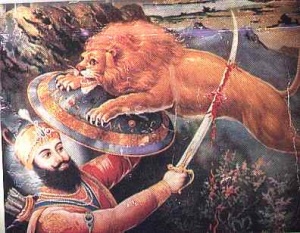Hunting in Sikhism
Hunting is great practise for warfare, using all of its skills. Sikh Gurus also engage in Hunting activities sue to their participation in wars which require lot of practice and also hunt furious animals which tease people. The Mongols were famous for there grand shikars that went on for weeks. Many of the skills learned on their hunts, aided them in conquering much of the world. Their decendants the Mughals who conquered India and the Panjab started their Empire in India when Babar brought those skills to India, along with their love of the Shikar, in the days of Guru Nanak. The muskets that the men of his son Humayun used to defeat the Rajputs (and gain the Koh-I-Nur) were some of the first guns used in warfare. The Mughal's even captured and trained Cheetahs to aid in their hunts.
Since the lion and the tiger are known as the most cunning and ferocious of beasts, one even being called the 'King of the Jungle', they have often been hunted as a test of one's courage.
Wearing their pelt or a necklace of their teeth or claws, were coveted as symbols of strength. The tiger, also said to be the beast downed by Guru Hargobind, has been hunted almost to extintion in India. Its bones are worth more than gold in China where wine fortified with tiger bone is thought to restore youthful virility.
Both Guru Hargobind and Guru Gobind Singh had encounters with the 'King of the Jungle'.
- Once when Guru Hargobind was hunting with Emperor Jahangir they stopped to spend the night at Bhamtipura village. The Sarpanch (head) of the village complained to the Emperor about a deadly loin who was stalking and killing the villagers of the area. The next morning saw the Emperor's men, in the usual manner of hunting lions, beating the bush to drive the beast towards the Eperor's party.
- Some people have said that the Emperor was planning to have the lion kill the Guru during the hunt, but since its hard to manage a beast like that, it is more likely that with his being the emperor he could have just arranged for a little 'friendly fire incident by arranging for one of his musketmen to shoot the Guru as the Lion attacked.
- But what history does record is that while the beaters were driving the lion towards the hunting party, the lion suddenly charged straight at Jahangir. Jahangir and his soldiers fired their guns and arrows at the charging beast, to no effect. The lion was almost upon Jahangir when Guru Hargobind jumped between Jahangir and lion and screamed out to the lion, "Ae kale yaman pehlan toon war kar lae kidre tere man di iccha baaki na reh jaye".
- The lion leaped with all his strength right at the Guru who raised his shield and deflected the lion's charge to the side, as he brought his sword down on the beast all but cutting the lion in two. We will never know if the Emperor had really intended any harm to the Guru, perhaps his men were too frightened to reload their guns or just were in such awe of the Sikh Guru's bravery in saving their leader that they forgot any plans to harm him.
- Jahangir no doubt was appreciative of the Guru for having saved his life, and certainly realised that the Guru was not just spirituality powerful but physically powerful as well.
- After this incident Muchukund became more popular among the Sikhs.
- Even though the Guru had saved his life, it wasn't long after they reached Gwalior, that the Guru ended up being held in confinement at Gwalior's fort. There are several stories with differing accounts of how the Guru came to be locked up at Gwalior. But everyone agrees about the end to the episode. Every year Guru Hargobind's sucess at freeing the 52 Rajas, that had been prisoners there for many years, is celebrated as Bandi Chhorh Divas.
- Guru Gobind Singh also killed a lion during the Battle of Bhagani. A famous Gurwara is named to remember that event, Gurdwara Shergah is situated in himanchal pardesh.
![]() This article is a stub. You can help SikhiWiki by expanding it.
This article is a stub. You can help SikhiWiki by expanding it.

